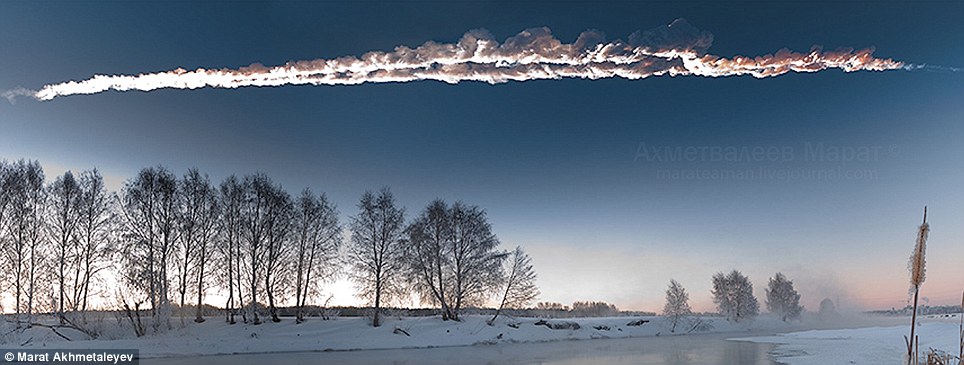
Figure 1. The Feb. 15, 2013 Russian Meteor's Trail Of Destruction:
The 100,000-ton space rock blitzes through the air before exploding.
The meteor that struck Russia on 15 February 2013 near the city of Chelyabinsk appears to be a comet fragment rather than an asteroid, about two times greater than its reported diameter. It is likely a comet fragment of 45 to 77 thousand tons, large enough to cause record cooling of the northern hemisphere. This analysis brings into question NASA's proposed orbit, mass and composition of this object.
Amazingly, the Chelyabinsk meteor event was co-incident with the passage of asteroid 2012 DA14, a body of only two thirds the diameter. Even more amazing was that there was near simultaneous co-incident 'UFO' activity near both these meteors. These are too many co-incidences to be ignored.
It is postulated that these co-incidences were intentionally staged to awaken mankind to the possibility of a potential comet fragment (dirty snowball) impact event in our near future. It may even be possible that an international human effort is underway to 'secret' the nature of meteors impacting Earth that could soon lead us into a new Ice Age.

With an estimated initial mass of 11,000 tonnes, and measuring approximately 17 to 20 meters across, the Chelyabinsk meteor is the largest object to have entered Earth's atmosphere since the 1908 Tunguska event and the 1930 Brazilian event, and it is the only meteor known to have resulted in a large number of injuries.The 2012 DA14 is a near- Earth (Aten class) asteroid with an estimated diameter of 30 meters (98 ft) and an estimated mass of 40,000 metric tonnes.
Coincidental Asteroid Approach
The Chelyabinsk meteor occurred 16 hours before the approach of asteroid 2012 DA14 to the Earth, which was the "closest ever predicted Earth approach" of an object its size. . . After an initial analysis of photographs from the site, scientists at the Sodankylä Geophysical Observatory in Northern Finland concluded that the two trajectories were widely different. Marco Langbroek (VU University Amsterdam) pointed out that it is impossible for fragments in orbits similar to that of 2012 DA14 to enter the atmosphere at a latitude as high as 55 degrees north
The Russians were quick to give an accurate account of the Chelyabinsk meteor event:
Russian Meteorite Blast Explained: Fireball Explosion, Not Meteor Shower - 15 February, 2013
Russian scientists investigating the meteorite explosion in the Urals explained the nature of the event that caused havoc in the region. NASA said the shockwave force was equal to a 500-kiloton explosion – 30 times the Hiroshima blast. . . The calculations were based on the data from infrasound stations across the globe, some being over 6,500 kilometers away from Chelyabinsk.Speculation soon arose that the meteor could be a comet (fragment).
Hunt For Celestial Fragments After Russia's Meteor Blast - 19 Feb. 2013
Within the academic community there appeared to be a difference of opinion on Monday as to the exact nature of the object, when some experts said it was conceivable that it was a comet that had struck south Russia at 9.20am on Friday. "In Chelyabinsk we saw a type of comet in which there was almost no meteorite remaining," said Alexander Bagrov, a member of the Russian Academy of Sciences' Astronomy Institute, Interfax reported.
"It was mainly made up of a mass of ice, of which no trace is left."
What is becoming very apparent is that only a few tens of kilograms of this meteor has been recovered despite reports that suggests its mass was in the tens to hundreds of thousands ton range.
Largest Russian Meteor Fragment Found - Feb 27, 2013
Russian scientists on Monday hailed the finding of what they said was the largest yet fragment of a meteorite that came crashing through the skies over Siberia and exploded over Russia's Ural Mountains last week.By 22 Feburary, a fairly accurate picture was coming out of Russia.
The find was among a large number of fragments brought back from the Federal University of the Urals by a ski expedition team.
"We haven't been able count [the fragments], but we believe it's more than 100," said Victor Grokhovsky, member of the meteorite committee at the university. "But the most significant among them was a fragment, which Masha PInkova found yesterday evening, not even 24 hours ago, that weighs 1.8 kilograms," he explained. "It's the largest fragment of this meteor that we have found to this day."
The most breathtaking pictures yet of Russian meteorite: Photographer captured exploding space rock on camera... despite thinking it was nuclear bomb that would kill him - 22 February 2013
He added: 'Immediately after that there was a series of bombings over the pine forest, a large number of birds rose up and flew in all directions.But NASA seems to be steering away from an official assessment of the meteor that exploded near the city of Chelyabinsk, an area where there is a concentration of weapons manufacturing and research. They are quoting an independent research facility, perhaps knowing that what is being released is questionable.
'My heartbeat, breathing, and hand tremors only got worse. The shock was even bigger'.
Mr Akhmetaleyev, who stood there 'stunned' for quite some afterwards, has now released his incredible pictures.
The 100,000-tonne meteorite exploded over Russia's Ural Mountains on Friday, injuring nearly 1,500 people and causing widespread property damage in city of Chelyabinsk. The debris narrowly missed a direct and devastating hit on the industrial city which has a population of 1.13 million but spread panic through its streets as the sky above lit up with a blinding flash.
What Exploded Over Russia (NASA)? - Feb. 26, 2013:
Western Ontario Professor of Physics Peter Brown analyzed the data: "The asteroid was about 17 meters in diameter and weighed approximately 10,000 metric tons," he reports. "It struck Earth's atmosphere at 40,000 mph and broke apart about 12 to 15 miles above Earth's surface. The energy of the resulting explosion exceeded 470 kilotons of TNT

The blast caused by this Russian meteor and its nominal location can be determined by various sensors and damage to the surrounding area can be fairly accurately estimated. Both Russian and USA analysts have deduced that it was equivalent to 470 kt of TNT or more. Models of how large and how high the meteor must be can be used to define the nature of this meteor. It has been proposed that this was a stony meteor, but there is very little evidence of such an object. A meteor made of organic ices and water seems much more likely given the few fragments collected so far. USA and Russian experts separately believe that the meteor was traveling at 40,000 or 33,000 mph, or about 11 mps or 9 mps respectively. It is unknown how these numbers were arrived at, possibly by radar data, but they are approximately the same order of magnitude, therefore significant inconsistency is considered unlikely.
The angle of approach of the meteor is not easy to define. So a range of several angles, 25o, 30o, 40o and 45o was considered. These do not have a strong influence on the size of the meteor. Likewise, these angles somewhat influence the nominal altitude where the meteor could be anticipated to explode or break up.
The Purdue Model of meteor
size, altitude, and break up energy will be employed to estimate the size and
mass of the meteor assuming that it going at the USA and Russian velocities and
at a given angle of approach. The size was adjusted so that a nominal 500 kt
blast is generated. Table 1 offers results of these calculations.
| Angle Of Approach | Velocity* | Meteor Diameter (meter) | Meteor Mass (ton) | Detonation Altitude (miles) | Blast Magnitude (kt of TNT) |
|---|---|---|---|---|---|
| 45o | 11 mps (USA) | 43 | 45,866 | 11.8 | 500 |
| 45o | 9 mps (Russia) | 49 | 67869 | 10.5 | 520 |
| 40o | 11 mps (USA) | 44 | 49,141 | 12.5 | 520 |
| 40o | 9 mps (Russia) | 49 | 67869 | 11.4 | 500 |
| 30o | 11 mps (USA) | 45 | 52568 | 14.7 | 510 |
| 30o | 9 mps (Russia) | 50 | 72109 | 13.6 | 490 |
| 25o | 11 mps (USA) | 46 | 56151 | 16.1 | 510 |
| 25o | 9 mps (Russia) | 51 | 76523 | 15 | 490 |
| Angle Of Approach | Velocity* | Meteor Diameter (meter) | Meteor Mass (ton) | Meteor Composition Density kg/m3 | Blast Magnitude (kt of TNT) |
|---|---|---|---|---|---|
| 25o | 11 mps (USA) | 46 | 56151 | Ice 1000 | 510 |
| 25o | 11 mps (USA) | 41 | 59638 | Porous Rock 1500 | 520 |
| 25o | 11 mps (USA) | 33 | 62194 | Dense Rock 3000 | 520 |
| 25o | 11 mps (USA) | 21 | 42740 | Iron 8000 | 520 |
Coincidence? Siberia Records Coldest Temperature Ever Days After Meteor
Explosion
Oymyakon, The Coldest Village On Earth: Temperatures Drop To -71.2C, Locals
Can't Wear Glasses Because They Freeze To Their Faces And The School Only Shuts
If It Falls Below -52C - May 2013
Only a few days after the meteor exploded over the city of Chelyabinsk in Siberia on February 15, the coldest temperature ever recorded in the country took place. The temperature— -71.2°C (-96.1°F)—was recorded on February 19 in the Siberian city of Oymyakon, some 2000 miles away from Chelyabinsk. The previous record for coldest temperature in the region was -68°C (-90.4°F) set in the year 1933.If fact, this is a low temperature record for the entire Northern Hemisphere.
The link between asteroid and/or comet impacts/atmospheric explosions has been noted extensively through scientific studies regarding intense climate change in the past, many which have led to mass extinction events on Earth.
New Record Low Temperature For Northern Hemisphere Set In Russia's Siberia - February 24, 2013
It seems like Russia continues to find a way to stay in the natural science news. Earlier this month a meteorite explosion was captured on numerous videos. Even this eyewitness account of the shock wave blowing out building windows. Now an 80 year old record appears to have been broken in the past week, but not much has been said about it. That record for the lowest temperature ever recorded in the Northern Hemisphere would rank as the coldest outside of Antarctica.
Should the Russian meteor have really been a comet, or a comet fragment, its speed is in question. Notice that comets usually travel much faster than asteroids and are harder to detect because they come at Earth from all directions. Notice also that there are no known Ice asteroids and it was probably a comet fragment(s) that killed the dinosaurs.
Comets Travel Much Faster Than Asteroids And Can Come From Any Direction?
As comets reside in the Kuiper belt and the Oort cloud they can indeed come crashing in from just about any direction while asteroids reside mainly in the ecliptic plane like the planets.Water Ice Discovered On Asteroid For First Time - 28 April 2010
Near earth asteroids orbit the sun at about earths distance to the sun. So they move at about the same speed. As comets "fall" towards the sun from "higher" up, way beyond the orbit of Neptune, the pick up a lot of speed and therefore move much faster than asteroids. So a comet impact would pack more punch than an asteroid impact with the same mass.
"This is the first time we've actually seen ice ? literally H20 ? on an asteroid," said one of the study leaders, Andrew Rivkin of Johns Hopkins University.Comet, Not Asteroid, Killed Dinosaurs, Study Suggests - 22 March 2013
"The average temperatures of asteroids (about 150?200 Kelvin) at this distance from the sun should cause surface ice to sublimate away in a matter of a few years or less,
Their calculations suggested the space rock generated less debris than previously thought, implying the space rock was a smaller object. In order for the smaller rock to have created the giant Chicxulub crater, it had to have been going exceedingly fast, the researchers concluded.Here are some typical speeds for relevant cosmic objects. Note that when estimating the velocity of an impacting meteor, its velocity must be added as a vector to Earth's velocity. Depending on the circumstances, the value is more or less equal to the Object's velocity +/- the Earth's velocity.
Comets are balls of ice, dust and rocky particles that are distinguished from asteroids by their highly eccentric orbits and thin, fuzzy atmospheres, called comas or tails. The Chicxulub impact is more compatible with a long-period comet, the results indicated, which can take hundreds, thousands or sometimes millions of years to orbit the sun once.
The Chelyabinsk Meteor's vapor trail was visible from space. See Figure 3 & 4.
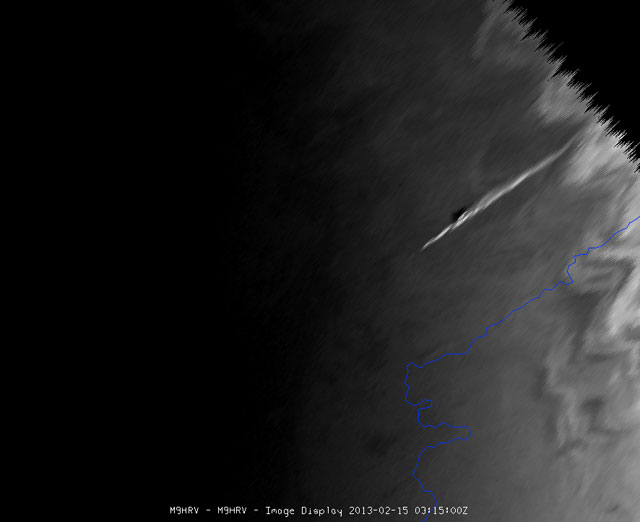

Astronomers Reconstruct Orbital Path Of Russian Meteor - 26 February 13
Its path was captured by dozens of cameras, many of which were mounted onto car dashboardsThe Apollo asteroids are those that most often threaten Earth. But what is important here is the above analysis is fraught with assumptions and irregularities. Others are finding major flaws with the above analysis.
That footage is the key to working out the meteor's trajectory. The astronomers were inspired by the work of technologist Stefan Geens, who writes about Google Earth on his Ogle Earth blog. He had wondered whether he could use meteor footage and Google Earth to come up with a rough mapping of the trajectory of the meteor as it entered the atmosphere using footage from a static webcam overlooking Revolutionary Square in the centre of Chelyabinsk. Its static position gave it a good look of the shadows cast by the meteor as it passed overhead, and knowing the heights of the lampposts in the square and the distances they stand apart gave Geens the data needed to calculate the meteor's height.
After reading this, astronomers Jorge Zuluaga and Ignacio Ferrin decided to build on it and see if they could work out the orbital path of the meteor, and thus where it originated from in the Solar System.
This information gave them what they needed to map the trajectory of the meteor within the atmosphere. They estimate that it was travelling between 13km/s and 19km/s, brightening up above Korkin when it was between 32km and 47km high. Using this information to plot a path through the sky, Zuluaga and Ferrin simulated 50 different possible orbits for the meteor through the Solar System based on their ranges of uncertainty. Their results lead them to state that "the Chelyabinsk meteoroid belonged unequivocally to the Apollo family of asteroids". Zuluaga and Ferrin concede that several assumptions underlie their work, from the inconsistencies in the timestamps on the different videos to accepting the theory that the hole in the ice at Lake Cherbakul is the meteor's final impact crater. However, the main problem was that, unlike the Revolution Square footage, the dash and handheld cameras were moving around, and weren't near static objects with easily researched physical dimensions like the lampposts -- the Korkin video was their least worst option. They also don't have a firm idea of the impact velocity of the meteor, which creates uncertainty in their estimates of its velocity when it entered the atmosphere.
If this trajectory is accurate, it means the meteor came from the Apollo group of asteroids that orbit on irregular axes around the Sun.
Andrew Cooper: Were the recent asteroid flyby and Chelyabinsk meteor strike events linked? - March 5, 2013
An interesting comment has been placed on the 2012DA14 flyby thread by talkshop regular ‘Scute’ (Andrew Cooper) which investigates the possibility that the Russian Meteor was indeed related to the asteroid. This was dismissed at the time but Scute’s investigation of the orbital dynamics seems to raise doubt about this:Thus, this possible orbit for the Chelyabinsk meteor is tenuous at best!
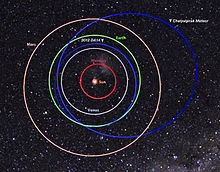
The
Apollo Asteroids
Some of these asteroids can get very close to the Earth, making them a potential threat to our planet.The Zuluaga and Ferrin analysis forces the orbit of the Chelyabinsk meteor into that of an Apollo asteroid. But what if it were a comet fragment? They are assuming the solution, and where is the evidence that indicates that this is a stony (chondrite) meteor anyway?
Angel is simply the ancient word for extra-terrestrial alien. This is not the first time an extra-terrestrial alien civilization intervened to save mankind from an impending cosmic impact event.
NOAH'S ARK – Verification of Alien Contact
The Book of Noah explicitly specifies that "angels" (with extensive metallurgical skills) built the Ark. They were likely the Nommos, an amphibian species reportedly from the Sirius star system. They left mankind with cuneiform writing and the wheeled vehicle (alien technology of that day). They offered us astronomical knowledge of their own and our solar system (including Vulcan) and evidence of a past major comet/meteorite Earth impact. Finally, they appear to have left repositories of technologies far more advanced than our own. Their story tells of an alien species' attempt to save a deceitful mankind from an approaching comet impact catastrophe that caused Noah's Great Flood. Apprehensively, they may have recently returned to again warn us of a similar impending impact event.There is much evidence that a cylindrical UFO was involved in the Chelyabinsk meteor event. The following pictures are image 'stills' of this UFO as it fly's by the meteor.
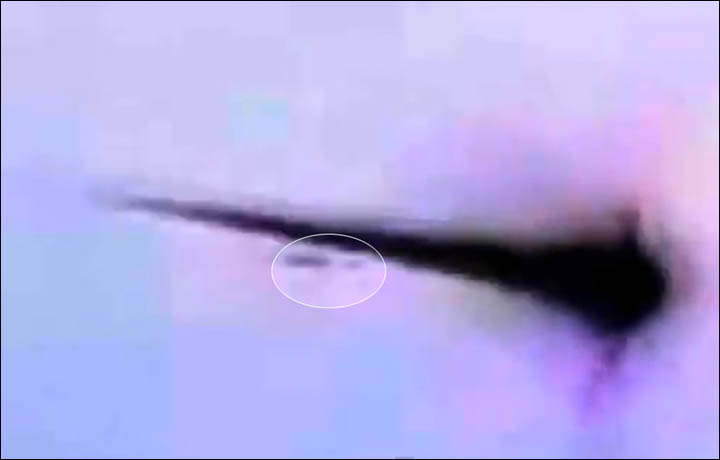
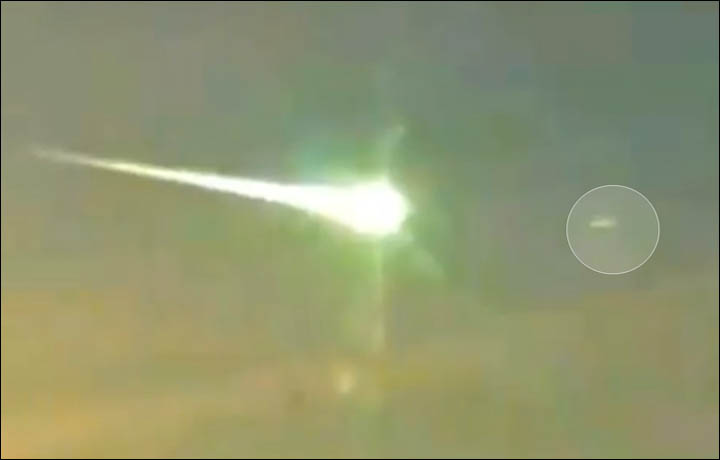
So Did A UFO Shoot Down The Famous Chelyabinsk Meteorite Last Month? - 28
February 2013
The meteorite that crashed to Earth in the Urals was attacked by a UFO causing it to explode and shatter, it was claimed on Thursday.But the UFO may be just due to the fact that it is from a dash camera and the car is turning.
Now attention has switched to whether - as a raging online debate suggests - 'we were saved by a UFO' exploding the menacing meteorite seconds before it struck the ground.
'At first, we also believed that the Chelyabinsk meteorite was just an ordinary meteorite, a cosmic body', said Alexander Komanev, coordinator for the Russian UFO community in Yekaterinburg. 'But facts began to emerge. In the internet began to appear videos, at least three of which were similar, on which you can see how an object catches the meteorite.'
This tiny object then 'flies through it - and the meteorite explodes and falls.
Russian Meteor Explanation - Mar 2, 2013
But here is a view from another perspective when the camera is stationary.
UFO Engages Russian Meteor? 2013 - Feb 19, 2013
Initially, it was thought was that it was a Russian ABM, the 'Gazelle' was involved. But it is doubtful that even this high speed missile has the ability to intercept this meteor moving at 11 miles per second. And the 'missile' or UFO remains in tact even after it passes by the meteor.
Another Look...Russian Abm (?) Hitting Incoming Meteor - Vid - Feb 16, 2013
Look just below the tail and see the UFO that catches up and runs into a meteor breaks it and goes off to the side.However, this seemed unlikely given the dynamics of the situation.
Meteor Strikes Russia, Intercepted By ABM - Feb 15, 2013
Comments
Assuming the published max speeds of the Gazelle interceptor missile are correct, it can reach 6km/s in the atmosphere.Russian authorities were quick to squash the 'shoot down' rumors, and they were correct to do so.
Could it be tracked? If it was detected in space, yes, if not then no. These rocks travel way faster than rockets ever can, it is only possible to 'intercept' these rocks when the rocket is already in place in front of it.
Meteorite Hits Russian Urals: Fireball Explosion Wreaks Havoc, Over 500 Injured - 15 February, 2013
According to unconfirmed reports, the meteorite was intercepted by an air defense unit at the Urzhumka settlement near Chelyabinsk. A missile salvo blew the meteorite to pieces at an altitude of 20 kilometers, local newspaper Znak reports quoting a source in the military.It is interesting to notice that there was also UFO activity around the asteroid 2012 DA14 that was suppose to pass by Earth later.
A spokesperson for the Urals regional Emergency Ministry center claimed it sent out a mass SMS warning residents about a possible meteorite shower. However, eyewitnesses said they either never received it, or got the message after the explosion had occurred. The Emergency Ministry has since denied sending out the SMS warning, and said the spokesperson that spread the false information "will be fired."
Observatory In Spain Captured Something Being Shot At 2012 DA14! - Feb 20,
2013
This is a video recorded from the La Sagra Sky Survey which is operated by the Astronomical Observatory Of Mallocra In Spain. The images were recorded on 02/15/2013 at approximately 12:59 PM P.S.T. The observatory states that they have no idea what the second object is shooting at DA14.
So what does all of this mean? The following are the results of the foregoing analysis of the Chelyabinsk meteor impact event:
An explanation offer is that an ET alien presence wanted to focus mankind's attention on cosmic comet-like Earth impacts while human attention was focused on a possible Earth threatening asteroid passage. It is asserted that they 'hurled' the Chelyabinsk meteor at Earth, not for purposes of harm, but to 'wake us up'. This meteor was carefully chosen and maneuvered in such a manner as to cause no fatalities among humans.
Chelyabinsk Meteor: The Space Rock That Scared Siberia - February 24, 2013
Thankfully, no fatalities or direct strikes by meteorite strikes on people were reported, but a wave of fear spread over Russian media and citizens, with one nationalist politician claiming that the meteor was a secret military maneuver by the Americans, a theory dismissed as farcical by the federal government.They ensured its safety by placing their own UFO within harms way should it have contained a significant amount of stone or iron. They linked their presence to both the Chelyabinsk meteor and the 2012 DA14 asteroid by being near both during this event.
Perhaps the ET aliens were trying to warning us of an Impending Impact Event, possibly one like this - 2016, Tollmann's Hypothetical Bolides Return. These are impacts that could lead to a new Ice Age and the loss of a third of the world's population. Would the elite want to keep such a threat secret?
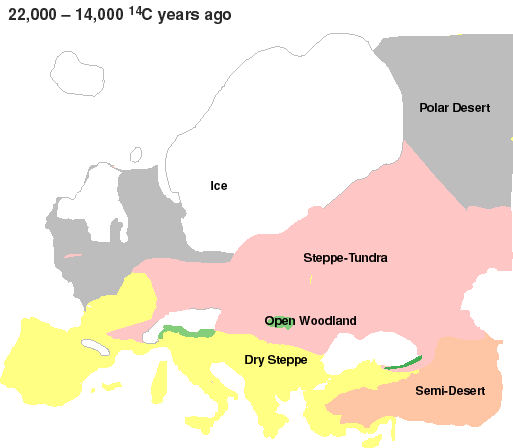
Despite the wretched way our government has treated captured ET aliens (We Have Been Tested And Found Wanting), they have put their lives on the line for us with their dangerously close passage to the exploding Chelyabinsk meteor.
Apparently, NASA, the Russians and at least one mainstream astronomer 'got the message':
Large Asteroid Heading To Earth? Pray, Says NASA - Mar 19, 2013
The events "serve as evidence that we live in an active solar system with potentially hazardous objects passing through our neighborhood with surprising frequency," said Representative Eddie Bernice Johnson, a Texas Democrat.
"We were fortunate that the events of last month were simply an interesting coincidence rather than a catastrophe," said Committee Chairman Lamar Smith, a Texas Republican, who called the hearing to learn what is being done and how much money is needed to better protect the planet.
Russia mulls beacons and nuclear bombs to save the world from asteroids - 12
Mar 2013
The ideas were prompted by an incident last month in which a meteoroid shattered over the Urals city of Chelyabinsk causing a sonic boom that left 1,500 people with injuries from broken glass and other debris.
The meteoroid which streaked over Chelyabinsk on February 15 exploded with the force of 30 Hiroshima bombs, and was thought to have had a mass of about 10,000 tonnes before it disintegrated. Only small fragments hit the ground.
We Live in a Cosmic Shooting Gallery - March 13, 2013
In this new video from Big Think, astrophysicist Neil deGrasse Tyson says he’s almost embarrassed for our species that it takes a warning shot across our bow before legislators take seriously the advice they’ve been receiving from astronomers about getting serious about asteroid detection and deflection; that it’s a matter of when not if Earth will get smacked by an asteroid. "But it took an actual meteor over Russia exploding with 25 times the power of the atom bomb in Hiroshima to convince people that maybe we should start doing something about it."And that's exactly what the Chelyabinsk meteor was, an alien warning shot across our bow, and a non lethal one at that. As Vatican watchers claim:
"Tom Horn - Hour 1 - Papal Resignation, Petrus Romanus & Exo Vaticana" - 1
March 2013
and:
video posted Feb 28, 2013
About 25:40 (to 27:00) minutes into the program, Tom Horn says that Exo-Vaticana is about a coming papal decree saying that belief in extraterrestrials is okay for Catholics, but denying the reality of extraterrestrials will be heresy because it limits God's creative ability. Also he said the Jesuits and Opus Dei have written in official church theology brand new doctrinal papers pointing to an imminent official disclosure moment for the Vatican to say that it's okay, and they are our space brothers who are closer to God than we are and they have come to show us the way.Sad to say, but those who are in positions of power and lead us are 'About As Far From God As One Can Get'.